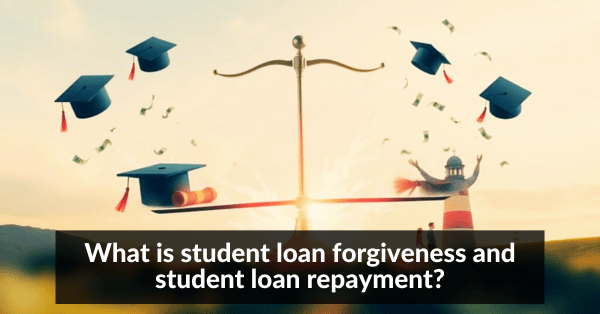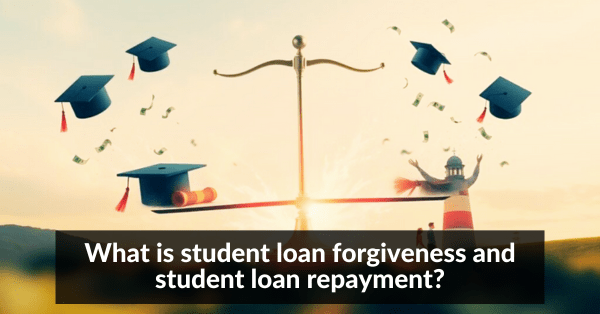Have you ever considered easing your education debt without hurting your financial future? It’s key to know about student loan repayment and forgiveness programs, which help us manage our education loans better.
Student loan repayment means paying back the money we borrowed for school. Forgiveness programs help some people get rid of their loans. By learning about these, we can handle our education debt wisely.

Key Takeaways
- Student loan repayment involves reimbursing borrowed funds used for education.
- Student loan forgiveness programs can significantly reduce or eliminate debt for qualifying borrowers.
- Understanding the eligibility criteria for forgiveness programs is essential.
- There are various repayment plans available, catering to different financial situations.
- These processes allow us to make better financial decisions regarding our student loans.
Understanding Student Loan Forgiveness Programs
Student loan forgiveness is a big help for borrowers. It lets us get rid of some or all of our loans, making getting out of debt easier. Knowing about these programs helps borrowers make intelligent choices for their money.
What is Student Loan Forgiveness?
Student loan forgiveness means we don’t have to repay some or all of our federal student loans. This happens for different reasons, like working specific jobs or following payment plans. It’s a big deal because it can save a lot of money.
Types of Student Loan Forgiveness Programs
There are many student loan forgiveness programs out there. They are made for different jobs and situations. Some main ones are:
- Public Service Loan Forgiveness (PSLF) – For those working in public service, like government or non-profits.
- Teacher Loan Forgiveness – For teachers in low-income schools or teaching in-demand subjects.
- Income-Driven Repayment Forgiveness – Forgives loans on income-based plans after a certain number of years.
Eligibility Criteria for Forgiveness Programs
It’s important to know what you need for forgiveness programs. Some everyday things you might need include:
- Making a certain number of payments on a specific plan.
- Working in a job that fits the program’s rules.
- Having federal loans that can be forgiven.

Student Loan Repayment Options We Can Consider
Managing our student loans is critical to our financial health. There are many repayment plans to fit different budgets and goals. We can look into federal plans and income-driven options for more flexibility and savings.
Federal Student Loan Repayment Plans
Federal student loan plans offer various options for different financial needs. Here are some common ones:
- Standard Repayment Plan: Fixed monthly payments that cover the loan in ten years.
- Graduated Repayment Plan: Payments start lower and gradually increase, typically every two years.
- Extended Repayment Plan: Allows borrowers to extend their repayment duration up to 25 years, with fixed or graduated payments.
Income-Driven Repayment Options for Student Loans
Income-driven plans are great for those with lower incomes. They adjust payments based on what you earn and your family size. This makes it easier to handle your payments. Here are some options:
- Income-Based Repayment (IBR): Caps payments at 10-15% of discretionary income, with forgiveness after 20-25 years.
- Pay As You Earn (PAYE): Similar to IBR, it may provide lower payments and forgiveness after 20 years.
- Revised Pay As You Earn (REPAYE): Covers interest better and provides forgiveness after 20-25 years, depending on whether loans are for undergraduate or graduate studies.
How to Lower Student Loan Payments
Lowering student loan payments is a top goal for many. Here are some ways to do it:
- Loan Consolidation: Combining loans into one can make payments easier and might lower interest rates.
- Refinancing: This could reduce interest rates based on your credit score and current rates.
- Autopay Discounts: Some lenders give lower interest rates if you set up automatic payments.
What is Student Loan Repayment?
Understanding student loan repayment is critical for those who have loans for school. It’s about how and when we repay our loans after graduation. This includes the payment schedule and how interest adds up, affecting what we owe. Using intelligent strategies can save us a lot of money.
Explaining the Basics of Student Loan Repayment
Student loan repayment usually starts six months after we graduate. This gives us time to get ready financially. Knowing the interest rates helps us figure out what we owe. Keeping up with payments is essential to avoid extra fees and protect our credit scores.
We should explore different ways to pay back our loans. This could mean making extra payments or adjusting our monthly payments based on our income. This will help us manage our debt better.
Student Loan Refinancing Options
Refinancing is a good option for many borrowers. It means getting a new loan to pay off old student debt, possibly at a lower interest rate. Lower rates mean smaller monthly payments and save us money over time. We can choose loans that fit our financial situation, especially if we have private loans. Looking at different lenders can help us find better deals.
Best Banks for Student Loan Refinancing
Choosing the right lender for refinancing is essential. When picking the best student loan refinancing banks, consider interest rates, fees, and customer service. Some top choices include:
| Bank | Interest Rate Range | Repayment Terms | Unique Features |
|---|---|---|---|
| SoFi | 3.50% – 8.99% | 5, 7, 10, 15, 20 years | Unemployment Protection, Career Services |
| Earnest | 3.20% – 7.99% | 5 to 20 years | Custom Payment Plans, No Fees |
| CommonBond | 3.74% – 8.90% | 5, 10, or 20 years | Social Promise Program, No Fees |
These options offer good terms for student loan repayment. Being informed helps us pick lenders that meet our financial goals.
Conclusion
Understanding student loan repayment and forgiveness programs is critical to managing education debt. We’ve looked at different options and why it’s essential to know them. This knowledge helps us make smart financial choices that fit our lives.
Knowing about student loan forgiveness gives us ways to reduce our debt. It also helps us handle loan repayment better. Whether we pick income-driven plans or look into refinancing, acting early can help our wallets.
As we deal with the costs of education, let’s learn about our options. Knowing what we can do can lead us to the best ways to ease our financial load. This way, we can move forward without the stress of big student loans.
FAQ
What is student loan forgiveness?
Student loan forgiveness lets borrowers get some or all their loans wiped out. This happens under certain conditions, like working in public service or teaching.
What types of student loan forgiveness programs are available?
Many programs include Public Service Loan Forgiveness (PSLF), Teacher Loan Forgiveness, and income-driven repayment plans. These offer forgiveness after making a certain number of payments.
How can I determine my eligibility for student loan forgiveness programs?
To get into these programs, you must meet specific requirements. These include your job type, repayment plans, and loan types. Check each program’s rules to see if you fit.
What are my federal student loan repayment options?
You have options like the Standard, Graduated, and Extended Repayment Plans. There are also income-driven plans that change your payments based on your income and family size.
How can we lower our student loan payments?
Lower payments can be achieved through consolidation, refinancing for lower rates, or income-driven plans. These options reduce your monthly expenses.
What is student loan refinancing?
Refinancing means getting a new loan to pay off old ones. It’s done to get a lower interest rate or better terms, which helps you manage your loans better.
Which banks are considered the best for student loan refinancing?
Top refinancing banks include SoFi, Earnest, and CommonBond. They offer reasonable rates and unique features, so it’s wise to compare them before choosing.
Can student loan repayment calculators help us plan our payments?
Yes, calculators are great for figuring out monthly payments. They consider your loan balance, interest rate, and repayment plan. This helps us understand our financial situation.
What are income-driven repayment options for student loans?
These options adjust your payments based on your income and family size, making it easier to manage payments during tough times.
